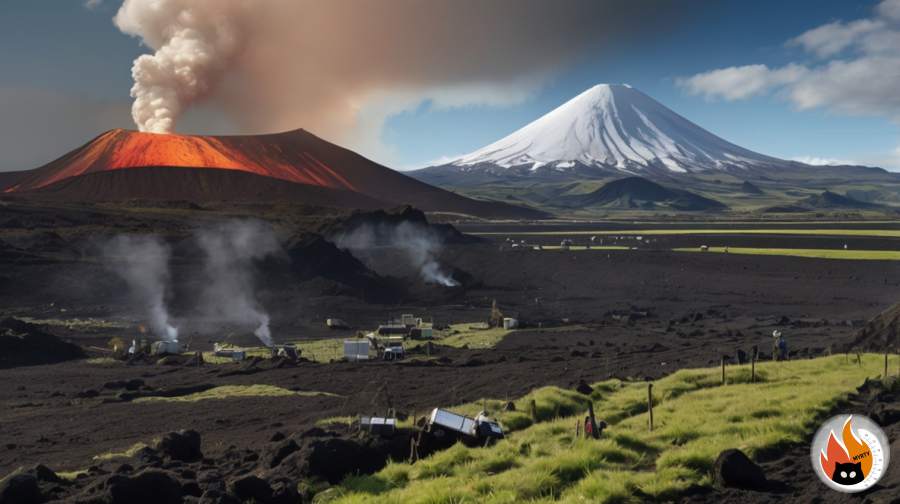The Year Without Summer: Exploring the Historical Volcanic Climate Disaster of 1816 and Modern Climate Monitoring Technology
In the realm of climate history, few events stand as starkly as the infamous “Year Without Summer” of 1816. This extraordinary period represents one of the most dramatic examples of how volcanic activity can dramatically alter global climate patterns, leading to widespread agricultural failure and human suffering. Yet, from this historical calamity emerged valuable insights that continue to inform modern climate science and monitoring technologies.
The Devastating Eruption That Changed Climate History
The catalyst for this climate anomaly was the catastrophic eruption of Mount Tambora in present-day Indonesia in April 1815. This was no ordinary volcanic event—it registers as the most powerful volcanic eruption in recorded human history, ejecting an estimated 150 cubic kilometres of material into the atmosphere.
The eruption released massive quantities of sulphur dioxide into the stratosphere, which formed a persistent aerosol layer that circled the globe and significantly reduced the solar radiation reaching Earth’s surface. This global dimming effect resulted in abnormally cold weather throughout the Northern Hemisphere in 1816, particularly affecting North America and Europe.
The consequences were severe and far-reaching. Across New England, frosts occurred during summer months, destroying crops and leading to food shortages. In Europe, persistent rain and cold temperatures led to agricultural failures, food riots, and economic distress. Contemporary accounts describe skies darkened by volcanic ash, striking sunsets with unusual colours, and dramatic temperature drops.
From Historical Disaster to Modern Scientific Understanding
While the immediate impacts of the “Year Without Summer” were devastating, the event has provided invaluable scientific data that continues to inform our understanding of climate systems and volcanic impacts. Today, we possess sophisticated technologies that would have been unimaginable to those who suffered through 1816:
Advanced Volcanic Monitoring Systems
Modern volcanology employs an impressive array of technologies to monitor volcanic activity and predict potential eruptions:
- Satellite Thermal Imaging: Instruments like the Advanced Spaceborne Thermal Emission and Reflection Radiometer (ASTER) can detect heat signatures from volcanoes, identifying hotspots that might indicate impending eruptions.
- InSAR Technology: Interferometric Synthetic Aperture Radar can detect minute changes in ground deformation, often a precursor to volcanic activity.
- Seismic Networks: Dense arrays of seismometers around active volcanoes can detect the subtle tremors that often precede eruptions.
- Gas Emission Monitoring: Changes in the composition and volume of gases emitted by volcanoes often signal changing activity levels.
Climate Modelling and Prediction
The computational power available to modern climate scientists would astound those who experienced the Year Without Summer:
- Supercomputer Simulations: Today’s climate models can simulate the complex interactions between volcanic eruptions and global climate systems with remarkable accuracy.
- Historical Data Analysis: By studying ice cores, tree rings, and other natural archives, scientists can reconstruct past volcanic events and their climate impacts.
- Aerosol Monitoring: Networks of ground-based and satellite instruments track aerosols in the atmosphere, helping to understand their distribution and effects.
Future Applications and Technological Frontiers
The lessons from 1816 continue to drive innovation in climate science and disaster preparedness:
Climate Intervention Research
The cooling effect observed after major volcanic eruptions has inspired research into potential climate intervention strategies. Scientists are cautiously exploring whether similar effects could be artificially induced to temporarily offset warming trends—though such approaches remain highly controversial and are accompanied by significant ethical considerations.
Agricultural Resilience Technologies
The food shortages of 1816 highlight the importance of agricultural resilience. Today, scientists are developing:
- Cold-resistant Crop Varieties: Using both traditional breeding and genetic technologies to create plants that can withstand temperature extremes.
- Advanced Greenhouse Systems: Controlled environment agriculture that can produce food regardless of external climate conditions.
- Predictive Agricultural Models: AI-powered systems that help farmers anticipate and adapt to changing climate conditions.
Integrated Early Warning Systems
Perhaps most importantly, modern technology enables integrated early warning systems that combine volcanic monitoring, climate modelling, and agricultural forecasting to provide governments and populations with advance notice of potential climate disruptions.
These systems would have been transformative in 1816, potentially saving countless lives by allowing for preparation and adaptation rather than devastating surprise.
Learning from the Past to Prepare for the Future
The “Year Without Summer” serves as a powerful reminder of our planet’s dynamic and sometimes volatile nature. While we cannot prevent volcanic eruptions, our technological capabilities allow us to monitor, predict, and respond to their effects with ever-increasing sophistication.
As climate change introduces new uncertainties into our environmental systems, the historical lessons of 1816 take on renewed relevance. By understanding how past climate anomalies affected human societies, we can better prepare for future challenges.
The remarkable silver lining of the Year Without Summer is that this climate disaster from over two centuries ago continues to inform and inspire scientific progress today. From the ashes of Mount Tambora has risen a wealth of knowledge that may help humanity navigate the climate challenges of the 21st century and beyond.
Take Action: Exploring Climate Resilience
Inspired by the lessons of the Year Without Summer? Consider these ways to engage further:
- Explore citizen science projects that contribute to climate monitoring and research.
- Support scientific literacy initiatives in your community.
- Investigate climate-resilient gardening and food preservation techniques.
- Advocate for continued investment in climate monitoring and early warning systems.
By understanding our climate past, we gain valuable insights for navigating our climate future—turning historical calamity into contemporary wisdom.
